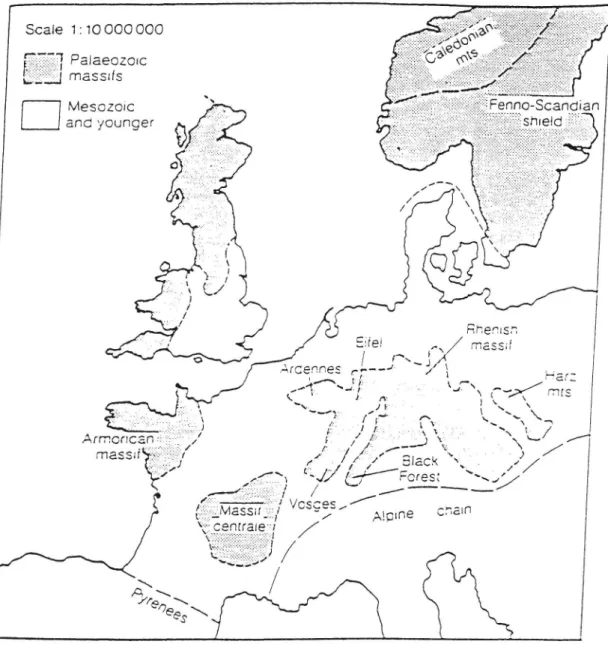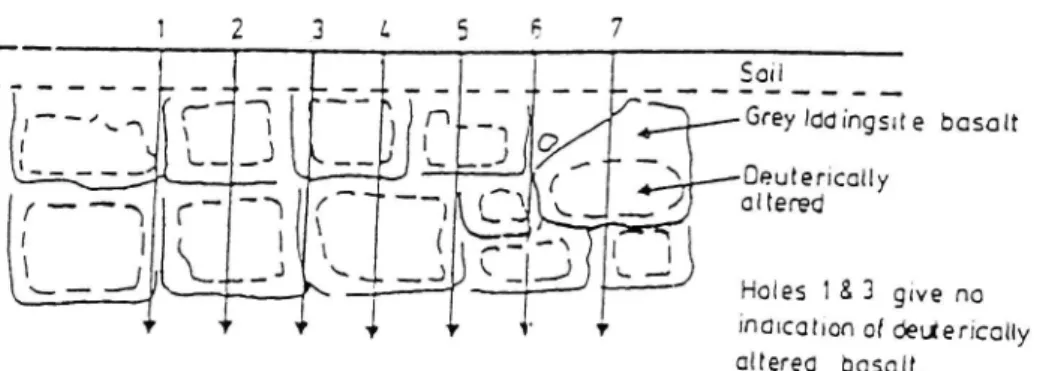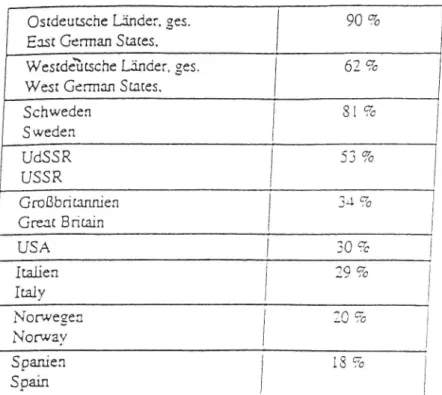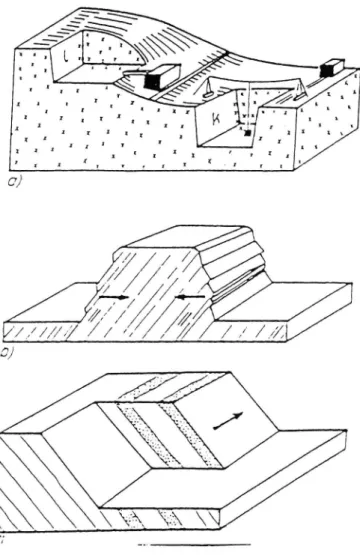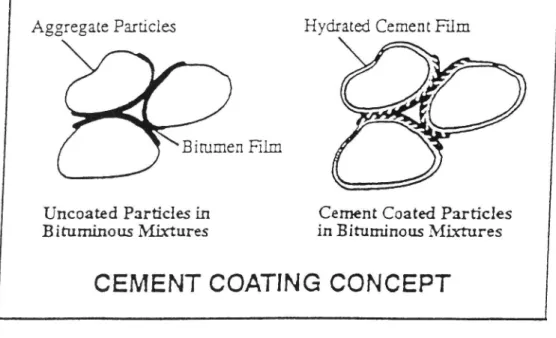VTI särtryck
Nr 215 0 1994
Opening of Quarries - Qualification of Sites
Peet Höbeda
Paper prepared for the OECD workshop A2 on Road
Aggregates for Central and East European Countries
in Varna, Bulgaria 25 28th May 1994
Väg- och
VTI särtryck
Nr 215 ' 1994
Opening of Quarries
Qualification of Sites
Peet Höbeda
Paper prepared for the OECD workshop A2 on "Road
Aggregates for Central and East European Countries
in Varna, Bulgaria 25 28th May 1994
41»
Väg- och
transport-farskningsinstitutet
'
Paper prepared for the OECD workshop A2 on "Road Aggregates" for Central and East European Countries in Varna, Bulgaria 25-28th May 1994.
OPENING OF QUARRIES - QUALIFICATION OF SITES. by Peet Höbeda, Swedish Road and Transport Research Institute
1. Introduction.
This presentation has been prepared at very short notice and it has not been possible to carry out any thorough research. Some references are given to publications worthy of further study. In the recent issue of Routes et Aerodromes (April 1994), a plea has been made for a trans-European motorway network, including Scandinavia and the countries of central and Eastern
Europe (including the Baltic states, Russia, Byelorussia and the Mediterranean region). This
network would be ready by 2020. Even without this proposal, which is of gigantic
dimensions, the need for aggregates in Europe is increasing. The infrastructure has a high priority in the present EC/EU Internal market. Also, as the former, state controlled economies in Eastern Europe develop into market economies, there are vast needs for improving old roads to modern standards. New roads and railways must be built, as well as various other structures. Recently, the situation regarding aggregates in Russia and the new Federal States of Germany (former DDR) has been treated (Butkewitch and Haro 1994, Lange 1994). Central planning has been characterised by a low degree of exibility, but at the same time it
sometimes offers some advantage from an enviromental viewpoint as mainly railways instead of lorries have been used for transports.
At the same time, it is going to be more and more difficult to obtain access to aggregate and this is especially valid for gravel and sand of alluvial or glacial origin, deposits that are not treated in this context. Alternatives must be sought and quarrying of rock deposits has the greatest potential for providing the quantities and qualities needed. However, rock is not always available and even if it is, several restrictions may exist. Because of geological history, vast areas of lowlands may be covered by thick soft rock or soil deposits. Figure 1, which only shows part of north-western Europe, gives an idea of the areas (named Palaeozoic massifs of early origin) in which solid rock for aggregate may be found. Large areas of Eastern Europe also lack solid rock, suitable for aggregate. The pattern of location does not always match the
pattern of demand. On the other hand, the situation, for example in Scandinavia (the Fenno
Scandian shield area), is especially favourable as the rocks are not weathered and the glacial soil cover is usually thin. The latest glaciation has also removed surficial, weathered rock. Because of favourable locations and suitable rock, a few superquarries (output several million tons/year) have been developed in sparsely populated coastal areas of Scotland and Norway. In densely populated countries with no solid rock, it has been possible to use recycled building rubble and of course bituminous mix, to replace substantial amounts of natural aggregate. In the Netherlands, recycled material dominates in roadbases and subbases and may in fact give especially stiff layers because of a weak cementing action. Other countries where recycling is well developed are Denmark and Germany. Presorting of the material before processing is necessary. An important aspect is that in such countries recycling is often subsidised by reduced taxation.
2. Suitability of aggregates.
Aggregates usually are classified by geological origin according to Figure 2. Artificial
materials are included and preferably also recycled products from roads and structures. It must be understood that the quality of an aggregate within one geological group may vary very widely and must be ensured by proper testing. The types of tests that should be used will depend on the type of aggregate and also the location in the road structure. In Europe, a large number of tests exist and it is the task of CEN TC154 to produce European Standards for the Internal Market. Test methods are of the "index type" and sometimes bear little relationship to performance in road layers. Few verifications appear to be available from test roads (investigations of wear of studded tyres and some other road surface properties are exceptions). Function related test methods are desirable, but do not always exist.
Alteration and weathering (Figure 3) are the most important factors for aggregate quality. In the Russian GOST 8267 82 aggregate standard, more importance is attached to weathering properties and climate conditions of the area where the aggregate is used than in most west European standards. However, the conditions vary greatly in such a large country. A French-Soviet cooperative investigation of testing methods has been performed (Jumasev and Tourenq 1984) and some relationships shown.
A petrographic investigation indicates which tests are necessary and which are irrelevant for a certain type of aggregate. In Scandinavia, for example, tests of weathering resistance or quality of fines are not specified. Also, it must be said that the quality of the aggregate
depends on processing factors (para. 4). Homogeneity is a property that does not always occur in rock deposits and aggregates produced from these. Relevant processing is therefore
especially important in inhomogeneous rock.
A suitable road aggregate should have the following characteristics, which can be divided into intrinsic (material dependent), manufactured and additional properties (the list below is a modified CEN TC154 SC4 proposal):
Intrinsic properties
Adequate strength (toughness)
Wear resistance (especially road surfacing) Durability (resistance against freeze-thaw etc) Rough surface texture
Polishing resistance (only surfacing aggregate) Hydrophobic characteristics "
Manufactured properties
Grading (depends on construction)
Particle shape ( akiness, elongation, crushed faces) Cleanliness (quality of fines)
Additional properties
Some special properties concerning, for example concrete durability and especially artificial aggregates may be included under this heading).
However, it is not very easy to differ between intrinsic and manufactured characteristics. For example, aggregate strength is dependent both on the mineral composition and texture, as well as on the processing and especially the crushing stages. Also, it may be dif cult to obtain a
"clean" aggregate from a weathered or altered rock source. The type of construction is of importance when comparing the in uence of different properties.
Turning to the petrological classification in Figure 2, some brief remarks can be made with the exception of arti cial aggregates. Igneous rocks are often suitable for aggregates and the quality mainly depends on their texture, e.g. mineral size and interlocking, as well as any stresses that have been involved in their geological histories. Quartz is a hard, but at the same time brittle, mineral. Ferro-magnesian minerals may produce toughness and hydrophobic surface characteristics, but alteration (Figure 3) is more frequent than in quartz-rich rocks. Metamorphic rocks may vary widely and thermal metamorphism (involving mainly heat) often produces hard, fine-grained rock. Regional metamorphism, which also involves high pressure can create foliated and mica-rich rock, and the aggregate produced may tend to be
aky. Sedimentary rocks vary widely, but a rough "rule of thum " is that limestone and sandstone are better the older they are. Argillaceous rocks often show fissility and are seldom used in upper pavement layers. If a petrographic investigation indicates altered or weathered aggregate or if the rock is of sedimentary type, a more extensive testing program is carried out.
In recent years, there has been an increase in traffic loadings on highways and thus a need for higher class aggregate in road layers. For satisfactory performance, a crushed aggregate of fairly large maximum size, preferably also with a rough surface texture, should be used. Good internal friction is thus provided. If using a lower quality, or especially a rounded aggregate, cohesion can be provided to compensate for a lack of internal friction, using for example polymer-modified bituminous binders. New types of road surfacings, such as stone-mastic asphalt and porous asphalt, require the use of crushed, high quality aggregate. This applies to both coarse and fine aggregate. These user-friendly bituminous mixes provide a good macro-texture and reduce traffic noise and spray in wet weather.
Also, specifying a very polish resistant aggregate to ensure resistance to skidding especially
when using hot-rolled asphalt (as in the UK) or to increase resistance to studded tyre wear
(Scandinavia except Denmark) has brought special aggregates onto the market. (Special aggregates that can be used in a thin surface layer and can withstand lorry transports over
hundreds of kilometres).
A good quality surfacing aggregate seems to mean different things in different countries. In Germany (and France?) basalts and related rocks are favoured. These rocks are very tough, but not as resistant to studded tyre wear as the more quartz-rich and brittle ne-grained aggregates (porphyries and quartzites) used on high volume roads in Scandinavia. Basalts and other rocks rich in ferro-magnesian minerals may also be altered. In the UK, a different tradition has developed using hot-rolled asphalt that seems to require the use of very polish resistant aggregates such as various sandstones, certain altered basalts etc, which are usually not very wear resistant (some confusion about wear testing has recently arisen in the ongoing CEN work as Micro-Deval and British Aggregate Abrasion tests do not measure quite the same properties) but the hot-rolled asphalt mix provides a binder-rich mortar that seems to protect the aggregate as in other types of mix (a porous asphalt needs an aggregate with especially good mechanical properties).
It can be seen from the above that an ideal surfacing aggregate does not exist and that the type of use of the aggregate is of importance. Also, different conditions and traditions (as well as
It is interesting to speculate about road surfacings, but the largest volumes of aggregate are used in other road layers, different lls and concrete. In lower road layers, aggregate of lower
quality can be used, as in the surfacing. On the global level, limestone is the most quarried
rock and is also an important industrial raw material. In fact, if good deposits exist, limestone may be favoured because of the ease of production of this rather soft rock (Lange 1994). On the other hand, a siliceous rock which is rich in quartz and also ne-grained will be very abrasive and expensive to produce.
The production of siliceous rock type aggregate (not identi ed in detail) in some countries is given in Figure 4 and it can be seen that limestone often dominates. Limestone may vary greatly in quality, but if a not too weak aggregate is used in a proper manner, it should give especially stiff and stable unbound layers under impermeable bituminous surfacings and also proper drainage is provided for. Some favourable (!) degradation occurs during compaction and with time weak cementation, as with certain waste materials may take place, and thus increase stiffness. Limestone also forms good bonds to bitumen and cement. However, if used as a road surfacing, homogeneous limestones are prone to traffic polishing and can only be used on low volume roads.
3. Problems when opening and working a quarry.
As conditions vary widely in different countries, it is very dif cult to generalise. The design of a quarry depends on geological factors, the volume of the deposit and its quality, depth and nature of overburden etc. The depth of overburden is of great importance for economy of exploition. Underground quarrying is in principle possible, but seldom considered
economical. However, underground openings formed during quarrying could later be used for storage or for industrial purposes, especially in urban areas. According to Poulin et al (1994), there are 113 underground quarries in the USA producing aggregates. The situation in Europe is not known.
When designing an open pit quarry or more often a hillside quarry, a working face of sufficient height must be obtained and Figure 5 shows how the geological situation may in uence the working procedure. The homogeneity of the rock and its hardness, jointing and thus block size and shape and tectonic disturbance (e.g. sheared and altered rock) are
geological factors of importance. If armourstone of large size is to be produced, the jointing system exerts a special influence on the sizes that can be produced. Geological site
investigations are always necessary. The extent of weathered or altered rock must be well known and Figure 3 gives an example from the Southern Hemisphere.
The geographical location and regional market situation are of importance and a quarry may produce industrial raw materials besides road and other construction aggregates (as is often the case with limestones, diabase for production of insulation wool etc.). Besides geological conditions, the spread of urban and recreational areas and necessity of zoning areas make it increasingly dif cult to work existing quarries and also to open new ones (Para. 5).
Governmental agencies tend to favour a few large quarries rather than several small quarries, but the competition situation is also important and a single quarry may obtain a monopoly. In special cases, smaller deposits of a very attractive road surfacing material may be worked.
Depending on the market situation, a plant may be stationary or mobile. A mobile plant may be motivated, for example, if rock in a road under construction can be used (as is often the case in Scandinavia) or if blasted rock is produced from temporary underground workings. In fact, there are no large quarries in the Stockholm area as rock from underground construction is abundant. (However, there may be a stationary plant without a quarry of its own).
Sometimes, mobile plants have been used by road authorities for increasing competition in an area where a monopoly has developed.
Mobile plants, often of different design to those for rock, may also be used for processing recycled or artificial materials which are often insuf cient for a stationary plant. Mobile plants are not under the same strict legislation as stationary ones, which may be an advantage in the market. If both natural and artificial aggregate is available, sometimes a mixture may be justi ed, especially for use as an unbound material. In such cases, a disposal problem may be
solved and possibly also sometimes a material of better quality obtained. In the USA, a mobile crushing unit may be used in the quarry itself and this unit may be connected with a conveyor belt to the main processing plant outside the quarry (Barksdale 1990).
A stationary plant in or near a quarry should be as close to a reliable market as possible. More effective processing of aggregate is possible than in a mobile plant and better control of dust and noise is achieved. Often, plants for bituminous mixes and concrete are integrated in the quarry if space is available. Unfortunately, an ideal location is not always possible as major urban areas are often located in lowlands and aggregates mostly in sparsely populated, more mountainous terrain (Figure 1). In habitated or recreational areas, aggregate resources are also
inaccessible because of conflict situations (Para. 5).
The technique and economy of quarrying depend on the extent of overburden stripping, drilling and blasting, crushing and sieving, washing, stockpiling, environmental protection systems etc. Production of fines may exceed the demand and ways should be sought for using this material for roads e.g. in capping layers, hydraulically bound pavement layers such as subbases etc. Special bituminous mixes with small maximum size aggregate can be produced for streets and parking areas etc. which are subject to low traffic stresses and the demand for
ne aggregate is then increased. Hahn (1988) indicates possibilities of using production
surplus (produced sizes with low market demand) and wastes (as overburden etc.) from
quarries.
Also, when finishing quarrying operations, costs are involved for restoration which can be carried out in different ways depending on the location (Para 5). In some countries, means for restoration must be deposited in a bank in advance (Sweden).
The cost of aggregate depends to a great extent on transportation costs. From the viewpoint of energy and the environment, transports by ship overseas, by barge on rivers or by rail are favoured. Large ships permit the cheapest transports and Scottish aggregate has been shipped to Houston, Texas (and grain, coal etc. brought to Europe as bulk goods from the USA). However, the cheapest and ecologically most harmless means of transport are not very exible and reloading is necessary. "Just-in-time" lorry transports are exible and therefore favoured. Quarries are not always located near railways and waterways. In the former DDR, railway deliveries accounted for 80% of total aggregate transports, but this gure has shrunk below 20% in this area after the introduction of a market economy (Lange 1994). Aggregates of high polishing resistance or wear resistance to studded tyres are a special case, as these are used in thin road surfacing, which is important from the road user s viewpoint. In such cases,
transport distances of several hundred kilometres may be justified (as in Sweden to reduce wear of road surfacing).
4. In uence of processing on aggregate quality.
Rock obtained by blasting contains fractures depending on the size of the particles and the cohesion between minerals, but these are largely eliminated during the crushing stages.
Reduction in stages reduces the amount of aky and elongated particles. However, very extensive "cubization" should be avoided as the aggregate interlocks and the layer stability may be reduced. Crushing an inhomogenous rock, especially a partially altered one with secondary minerals (chlorites, clay minerals etc), leads to a selection of the stronger
components in the aggregate as the weaker, often unsound components, are reduced to nes. This fine material of poor quality is produced in excess and may be dif cult to utilize when handling such a rock, prescalping before or screening after the primary crusher should be performed. If working very inhomogenous materials, containing soft components, very special procedures such as elastic fractionation or heavy-media treatment have in a few cases been carried out, mainly when working gravel. Another idea for improving a bituminous mix aggregate, which may be porous, rounded, smooth in surface texture or hydrophilic, is to pretreat it with a cement slurry in the plant (Figure 6). This technique has formerly been used in Kuwait to cope with adhesion and rutting problems of bituminous mixes.
5. Environmental issues.
When opening a new quarry, it is important to consider means of concealing it without disturbing the landscape and also to protect people in the neighbourhood from blasting vibrations, ying rock, dust, noise and disturbance from lorry transports. Unfortunately, crushed rock is often located in attractive, hilly or mountainous terrain. However, when quarrying operations are finished, positive amenities can be created, e.g. new industrial and residential areas, landscaping and revegetation can form attractive recreational areas with arti cial lakes etc. Another, more controversial issue is the use of old quarries for waste
deposits, if the strict conditions for pollution control can be ful lled (Schmitt 1994).
Different legislative systems exist in different countries on the governmental and local level. The situation in Europe is to some extent described by Berger (1991) and in the USA by Poulin et al (1994). Also, it is difficult to foresee what impact the European Union in Western
Europe will have on legislation in the near future. In Sweden, for example, three laws must at
present be considered when applying to open a new quarry and an "environmental
consequence description" must be provided. An M. Sc. project has recently been carried out (Sander 1993) to investigate an evaluation model for different environmental potentials. An existing Austrian model ("Naturraumpotentiale") has been presented and discussed. In such a model, geological resources are evaluated numerically and this value is compared with values for environmental potentials in the surroundings, taking into account aspects such as water supply, protection of nature or cultural sites, dwellings etc. It is always dif cult to numerically de ne often rather abstract environmental issues and also the geological data has a degree of uncertainity.
6. Surveying of rock deposits for aggregate production.
In many countries, surveys for sources of aggregates are carried out and these are described in the literature. Often, gravel and sand deposits have been of prime interest, but also alternative materials such as crushed rock have been considered. Sometimes, such investigations concern a whole country and the mapping is then on a small scale. At other times, they concentrate on a larger scale on certain regions and especially neighbourhoods in urban areas, as well as proximity to roads, railways or waterways. In such cases, also testing of samples may be justi ed. Databases with access to the gathered data exist for example in Scandinavian
It would be an interesting task to compare methods used in different countries in Europe, and also to work out a more or less detailed European aggregate resources map. However,
different testing methods hinder the comparison of aggregate qualities.
7. Proposals.
To summarise, some more or less realistic ideas for future cooperation on the European level are suggested. In fact, some work may be already in progress in UEPG, European Union of Granular Material Producers, where Hungary is a member in addition to the western countries (Berger 1991):
Work out a proper aggregate quality classi cation system, more function related than the present "quasigeological" systems.
At a later stage, when the first generation of European Standards for aggregates and road layer materials exists, start "prenormative research" to develop new and more function related tests which can be readily accepted by different countries. This is a formidable task!
Compare aggregate resources on a European level, using primarily existing information. Outline especially areas lacking in aggregate resources.
Compare legislations in different countries. Try to quantify exploitable aggregate resources and also the environmental issues on a European leVel. This is a very time-consuming and difficult task and language difficulties are hard to overcome!
Methods for upgrading and better use of of marginal materials should be studied and
implemented. Overspecifications, using non relevant tests, should be avoided.
The use of alternative materials should be seriously considered in all countries and recycling operations should be obligatory.
8. References.
Arquie,G, Tourenq,C. Granulats. Presses de l Ecole Nationale des Ponts et Chaussees. 1990.
Barksdale,R,D (editor). The Aggregate Handbook. National Stone Association, Washington 1991.
Bell, G. Methods of exploration and evaluation of quarries. Australian Road Research Board, Research Report No 80, 1977.
Berger,R. L Europe des Granulats. Industrie Minerale-Mines et Carrieres, jan. 1991.
Butkewitc h,G,R, Haro,O,E. Russian Rock. Aggregates in Russia. Rock Products, March 1994.
Hahn,U. Verwertungsmoglichkeiten fiir Reststoffe der Industrie. Die
Jumasev,V.M, Tourenq,C. Utilisation de granulats tendre dans les chaussees. Bullentin of the Association of Engineering Geology No 30, 1984.
Lange,R. Development of mineral aggregates production in the new Federal States (East). Die Naturstein Industrie nr 2, 1994.
Poulin,R et al. Aggregate resources: Production and enviromental constraints. Environmental Geology (1994)23.
Prentice,J,E. Geology of Construction Materials. Chapman and Hall, 1990.
Sander,A. Evaluation model for environmental potentials. Application for aggregates (in Swedish with an English Summary). Swedish Geological Survey. Report No. 77; 1993.
Schmitt,G-P. Wiederaufbereiten und Deponieren in Steine und Erdenbetrieben. Die Natur-stein-Industrie nr 3, 1994.
Smith,M,P, Collis,L (editors). Aggregates. Geological Society Special Publication No. 9. 2nd
Ed. Geological Society, London 1993.
Wagenbreth,O. Techniche Gesteinskunde. Naturwissentschaftliches Grundwissen fiir Ingenieure des Bauwesens. Band 3. VEB Verlag 1977.
Wingarth,J-A. Plea for a truly trans-European network. Revue Generale des Routes et des Aerodromes. April 1994.
Scale 1: 10 000 000 f? Palaeozom __
masszfs
ååå-Scandia
?shieid få? Mesozoic and younger % Eire) Fax j Arcs-ones ppm-J» * \l ._ _ \ f. x *x____, _ //f1-'- - ( xx \ --- ._..;-_'. \ );, / 54: ' - rx \ xx- \-\ Armoncan: 'x, ;; / / _. , x __ fl:- " f v. /- ' z /Figure l. Map of north-west Europe, showing areas of older rocks (shaded), often favourable
for aggregate producrion (Prentice 1990).
Road aggregates J
l Ä
l l
Igneous (Sedimentary ] [ Metamorphic I
Basalt Flint Hornfels
Gabbro Gritstone Quartzite Blastfurnace
Granite Limestone Schlst slag
Porphyry Burnt shale Gravel
Sand
Figure 2. Principal types of road aggregate (including sand and gravel as a subgroup). Prentice 1990.
Grey ladingsate basalt Oeuterically
altered
Holes 183 glve no
inalcatlon at deuerlcolly altered basalt.
Figure 3. An example of exessive rock alteration and weathering in a warm climate.
Osxdeucsche Länder. ges.
East German States,
Westde csche Länder, ges.
62 %
West German Stures.
Schweden , 8l % Sweden UdSSR 53 % USSR Groancannien 34 % 7 Great Britain !
[WUSA
)
:o %
l
Italien
'
29 %
**
Ital)l Norwegen 20 % % Norway Spanien l8 % SpainFigure 4. Production of silicate rock material as percentage of natural stone in some countries (Lange 1994).
V i x T_x W
..
cf L
Figure 5. Examples of quanying situations, a) hill side and open pit quany, b) in uence of dip
on working
face conditions and c) most favourable and safe working conditions foilowing the strike (Wagenbreth 1977).
Aggregate Particles Hydrated Cement Film
Uncoated Particles in Cement Coated Particles Bituminous Mixtures in Bituminous Mixtures
CEMENT COATING CONCEPT
Figure 6. Pretreatment of a marginal aggregate with cement paste before introduction in the bituminous mix (Texas Transportation Institute, Summary Report 1253-15, 1993).
